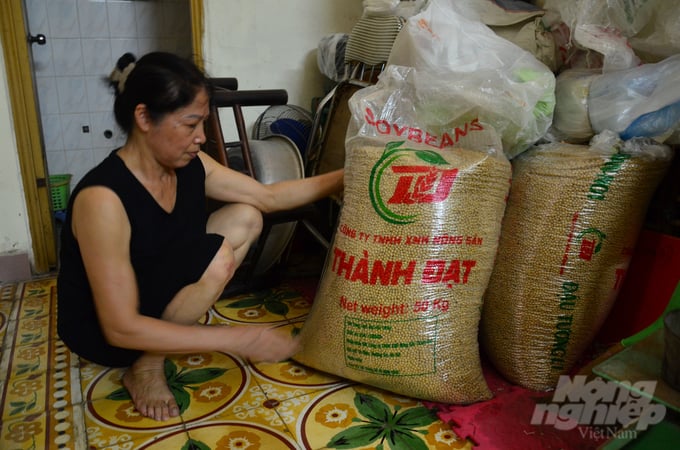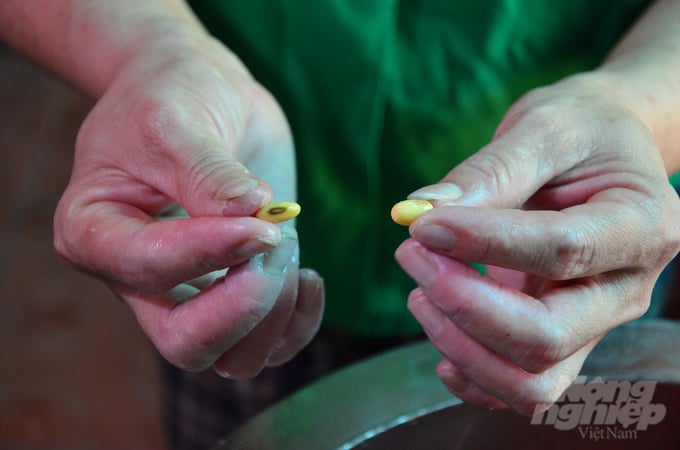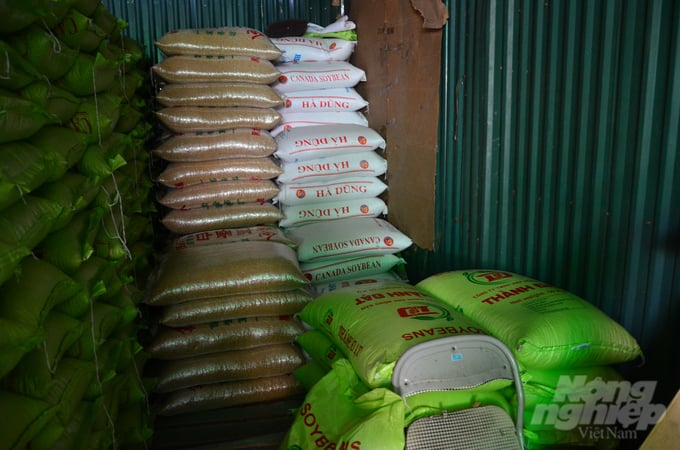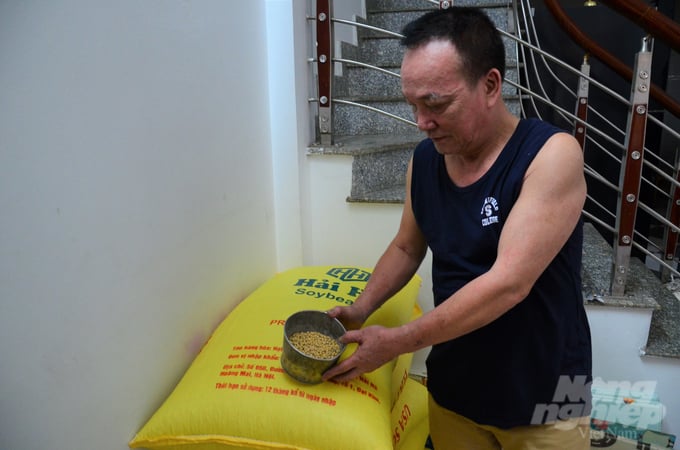June 21, 2025 | 02:09 GMT +7
June 21, 2025 | 02:09 GMT +7
Hotline: 0913.378.918
June 21, 2025 | 02:09 GMT +7
Hotline: 0913.378.918
Vietnam Agriculture News wishes to publish a series of articles to make things clear between beans imported for animal feed and food, sharing the message of complying with labeling for genetically modified products.
One year after the first Mo tofu traditional craft contest, I came back to a familiar bun stall near Mai Dong communal stall in Hoang Mai district, Hanoi. When she knew that the customer wanted to ask about her hometown's specialties, the owner immediately picked up a few pieces of golden fried tofu and said, "You try it, tofu straight from our Mo village!”.
I chewed slowly, but couldn't find the fatty, aromatic, delicious taste I remembered. I wanted to find out what had changed that famous piece of Mo tofu.
Legend has it that Nguyen Tam Trinh, the founder of Mai Dong camp, a general under the flag of two Trung sisters, was the one who taught people how to make tofu. The cool and clear water of Mo village, along with our native soybean seeds made the tofu here the best in the capital.
In the past, in order to make tofu, people used to choose soybeans very carefully. The seeds had to be evenly round, then left to dry, crushed in half to peel off the skin, soaked, milled, cooked, mixed with sour water to precipitate into "bean brains". The "bean brain" was later put into a towel to wrap and squeeze out cool, smooth tofu with four signature curved corners.

Producing Mo tofu at Ms. Hong's workshop. Photo: Duong Dinh Tuong.
I walked around the communal house, looking for production facilities based on the list of households participating in the Mo tofu contest. The workshop of Ms. Nguyen Thi Hong, who won the second prize, has three employees, an 88-year-old mother and two daughters Vu Thi Minh, Vu Thi Thuy. They get up at 3 am and work continuously until 12 noon everyday. On average, they use 17 - 20 kg of beans to produce 500 - 600 blocks of tofu, each block sells for VND 1,500, making them earn over VND 100,000/person.
Although there are grinders and filters, they still basically produce manually, cooking with charcoal stoves. Other stages are not much different from the old days, only the soybeans changed.
Ms. Minh led me to a corner of the house, pointed at a few bags of beans, and said, "In the past, there were soybeans from Ma River (Son La), Cao Bang, and Lang Son, delicious but after a few decades it is not available anymore, now we must use imported goods, mainly Canadian soybeans, VND 18,000/kg. Each time we take 300 - 500 kg. Just make a call and the merchant would deliver. They are not in the village, but somewhere else”.
Ms. Hong recalled the time when her family in the village worked in the fields and sowed beans. Now that field becomes houses, and those young village boys and girls become 80 - 90 year old men and women.

Imported soybeans used to make tofu at Ms. Hong's workshop. Photo: Duong Dinh Tuong.
The workshop of Ms. Tran Thi Tang and her husband is nearby. It has the largest scale in the residential group with 4 workers, using 50 kg of beans a day to produce 1,500 blocks of tofu.
When I came to ask about the workshop’s inputs, she said, "For decades, we have not had our hands on native soybeans. Only Chinese, American and Canadian goods are shipped. Canadian beans are VND 17,000/kg, and Chinese beans are VND 25,000/kg because the beans are more beautiful and delicious. Our old soybeans, though fragrant, usually had rotten and bad ones mixed in. We used to have a hard time picking them, but for foreign beans, ten out of ten look the same".
Ms. Trieu Thi Lun is the oldest person still keeping the traditional craft. At the age of 90, she still washes and peels beans with her son Nguyen Thanh Hai and daughter Nguyen Thuy Hong everyday. Their workshop won third place last year.
Ms. Hong was still full of regret when mentioning soybeans in Lang Son and Ma rive. They were very tasty and suitable for tofu production, but those places now thrive because of good border trade. A man working there for one day can earn money equal to an entire soybean crop, so almost no one plants it anymore.

Tofu production in Ms. Lun's workshop. Photo: Duong Dinh Tuong.
In the delta below, the riverbanks have changed to other vegetables. The industrial zone gradually encroached on the fields, so there is basically no longer native soybean crop.
Opening two drums, taking out a few beans from them and then spreading them in her hands, Ms. Hong explained: “Chinese beans are round and have no black brow, while Canadian beans are long and have black brow. In the past, our native soybeans were dried under the sun to create very sappy, fatty soybeans. Imported soybeans went through a dryer, losing all of their sappy characteristics, meaning they are no longer as delicious”.
When I mentioned the fact that most imported soybeans are genetically modified organisms (GMO), Ms. Hong burst out laughing: “How can there be genetically modified soybeans? It was just people saying nonsense". Could not blame the tofu producers though, because looking at the packaging of the beans they imported, there was not a word related to GMO.

The difference between Chinese beans and Canadian beans. Photo: Duong Dinh Tuong.
Thanks to the information from some Mo tofu makers I got to the southern wholesale market, approximately 2 km from Mai Dong. There was only one shop selling soybeans here, and the bags stacked up to half of the shop. Mr. Nguyen Duy Hai, an employee of the store said that he used to make tofu in Bac Ninh and then had to leave to do soybean trading for 10 years, so he knew quite well about the business.

A corner of soybean storage at the southern wholesale market. Photo: Duong Dinh Tuong.
“We are currently an agent of Lam Son Company (Thai Binh). We also sell products of Ha Dung Company (Hung Yen) and Thanh Dat Company (Hanoi). Basically here we only supply to tofu production facilities, mainly the Hanoi market. Particularly for Mo village, we sell to 5-6 households, and the rest buy from other places”.
“Are the imported beans GMO goods or what?”, I asked. Mr. Hai replied: “Yes, I know that. The soybeans currently being sold by Lam Son Company are said to be GMO goods, so are the goods from other companies”.
Calling the phone number on the website of Lam Son Company the operator gave me the number of Ms. Thu, the one in charge of the soybean segment in the domestic market. Because of her business in this field, Ms. Thu had done prior research, so she knew that native soybean production was low and could not meet the market demand. People often bought it to make food, but mainly for tofu pudding (like douhua in China), not tofu. “There are times when native soybeans are pricier than imported soybeans by up to VND 10,000/kg, while the protein ratio is low and not many finished products can be made even though they are delicious”.

Imported soybeans are now commonly used to make tofu. Photo: Duong Dinh Tuong.
According to Ms. Thu, there are actually two types of goods, GMO and non-GMO. The price is relatively different. But at this time, no non-GMO shipments have been imported. “If Lam Son beans sell for VND 16,000 - 17,000/kg, it is GMO. The non-GMO should cost more than that. Almost everyone on the Vietnamese market is using genetically modified soybeans because they cannot handle the price of non-GMO beans".
Translated by Samuel Pham
![Turning wind and rain into action: [9] Digitizing hydrometeorological data in response to climate change](https://t.ex-cdn.com/nongnghiepmoitruong.vn/608w/files/news/2025/06/17/z6704423696987_15fd32ffc26d590d204d520c9dac6786-nongnghiep-165943.jpg)
(VAN) Farmers have begun accessing hydrometeorological applications to adjust their cropping schedules, aiming to ensure productivity and adapt to climate change.
![Turning wind and rain into action: [8] Real-time salinity detection and early warning technology](https://t.ex-cdn.com/nongnghiepmoitruong.vn/608w/files/news/2025/06/17/z6704423696987_15fd32ffc26d590d204d520c9dac6786-nongnghiep-151127.jpg)
(VAN) Thanks to the integration of modern hydrological-hydraulic models, remote sensing technologies, and artificial intelligence, the accuracy of hydrological forecasting has significantly improved.
![Turning wind and rain into action: [7] Early disaster warnings help marine farmers minimize losses](https://t.ex-cdn.com/nongnghiepmoitruong.vn/608w/files/news/2025/06/17/z6704423696987_15fd32ffc26d590d204d520c9dac6786-nongnghiep-142942.jpg)
(VAN) In recent years, thanks to early disaster warnings and forecasting, marine farmers in Khanh Hoa province have been able to reduce risks and losses, thereby improving production efficiency.
![Turning wind and rain into action: [6] ‘Four on-the-spot’ disaster management software](https://t.ex-cdn.com/nongnghiepmoitruong.vn/608w/files/news/2025/06/17/e5a48259d6a262fc3bb3-nongnghiep-183800.jpg)
(VAN) By simply activating the scenario on the disaster management software, the relevant authorities immediately know how many households need to be evacuated, where to evacuate them to, and by what means of transportation…
![Turning wind and rain into action: [5] Hue applies modern technology in disaster forecasting](https://t.ex-cdn.com/nongnghiepmoitruong.vn/608w/files/news/2025/06/17/z6704423696987_15fd32ffc26d590d204d520c9dac6786-nongnghiep-093938.jpg)
(VAN) In Hue city, modern technology has recently been applied in meteorological and hydrological forecasting and warning, helping to reduce the damage caused by natural disasters.

(VAN) A cutting-edge farming technique being implemented on an experimental ranch in Arizona's Sonoran Desert has already saved a billion gallons of water over five years, according to Civil Eats.

(VAN) Poultry and pig production and the environment can be boosted through enhanced water technology, according to new research.